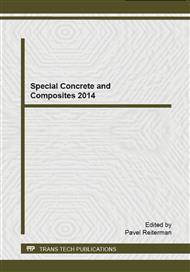p.221
p.227
p.234
p.238
p.243
p.248
p.254
p.258
p.262
Destructive and Nondestructive Characteristics of Old Concrete
Abstract:
This paper aims at determination of mechanical properties of 28 years old concrete with various nondestructive and destructive testing methods. All investigated parameters were determined on drilled cores with diameter 79.8 mm gained from existing bridge. On these samples Schmidt rebound testing and destructive force loading test were performed. Static (from loading test) and dynamic (measured by ultrasonic device) modulus of elasticity was also measured. The evaluation of destructive and nondestructive testing was according to the Czech Standards. Testing of old concrete from real structures is important especially prior to the reconstruction, strengthening or repair of the structure, when the structural engineer needs to know the characteristics. The compressive strength measured destructively on cylinders achieved average value 28 MPa, while the Schmidt rebound hammer test showed strength 44 MPa. The average value of static modulus of elasticity was 26 GPa.
Info:
Periodical:
Pages:
243-247
Citation:
Online since:
October 2014
Authors:
Price:
Сopyright:
© 2014 Trans Tech Publications Ltd. All Rights Reserved
Share:
Citation:


